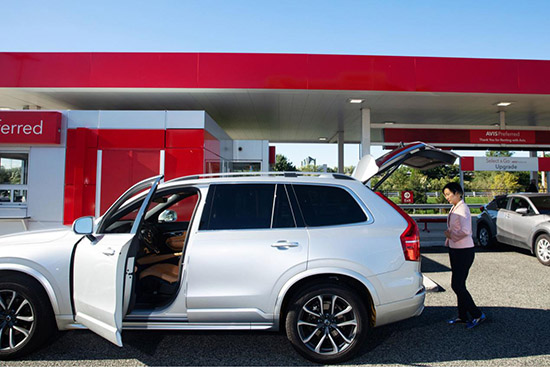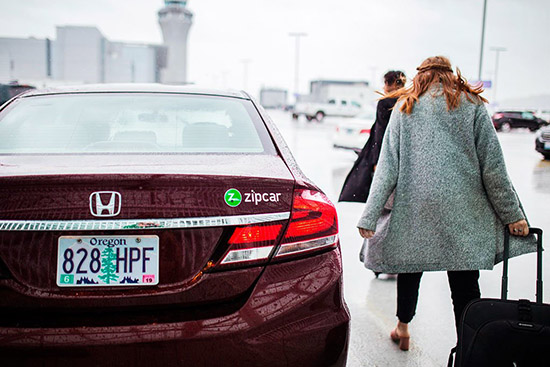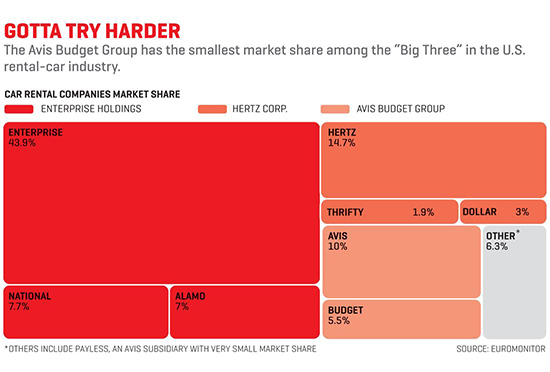網(wǎng)約車(chē)大行其道,,這家汽車(chē)租賃公司該如何逃出生天,?

|
世間還有比在機(jī)場(chǎng)租車(chē)更糟糕的體驗(yàn)嗎?旅客在經(jīng)歷了長(zhǎng)時(shí)間的飛行之后登上擁擠的擺渡車(chē),,然后在柜臺(tái)前加入排隊(duì)大軍,,等待你的將是保單和GPS設(shè)備的強(qiáng)行推銷(xiāo)。(專(zhuān)業(yè)建議:手機(jī)中已經(jīng)內(nèi)置了GPS模塊,。)接著就是上停車(chē)場(chǎng),,在無(wú)數(shù)輛相同的轎車(chē)中尋找屬于自己的那輛車(chē)。尤其當(dāng)我們提到租車(chē)行業(yè)時(shí),,說(shuō)句不好聽(tīng)的話(huà),,在當(dāng)今這個(gè)社會(huì),科技已經(jīng)大大提升了大多數(shù)常規(guī)性流程的速度,,但消費(fèi)情報(bào)公司J.D. Power 發(fā)現(xiàn),,2017年提取租賃車(chē)輛所需的平均時(shí)間反而比2013年增加了兩分鐘。 如果你希望看到整個(gè)業(yè)務(wù)模式能夠一夜間消失,,那么,,租車(chē)行業(yè)的很多員工亦會(huì)失業(yè)。這些公司希望,,不久之后,,人們無(wú)需在柜臺(tái)前辦理的各種復(fù)雜手續(xù)。等到了停車(chē)場(chǎng)之后,,人們可以用智能手機(jī)啟動(dòng)汽車(chē)大燈,,這樣便可以輕易找到自己的那輛車(chē)。你可以用手機(jī)開(kāi)車(chē)鎖,,啟動(dòng)汽車(chē),,然后駕車(chē)離開(kāi),無(wú)需在出口加入另一個(gè)等候隊(duì)伍,,在出口處等待拿備胎或給輪胎放氣,。這還是你去停車(chē)場(chǎng)的情形:未來(lái)某一天,租車(chē)公司可能會(huì)直接讓自動(dòng)駕駛汽車(chē)前往機(jī)場(chǎng)去接你,。 Avis Budget公司的首席執(zhí)行官拉里·德·肖恩表示:“在未來(lái),,我們無(wú)需在柜臺(tái)接待客戶(hù)。”每一家租車(chē)公司都在朝這個(gè)方向努力,,但作為美國(guó)租車(chē)行業(yè)三巨頭(其他兩個(gè)是赫茲和Enterprise)中市場(chǎng)份額最小的企業(yè),,Avis正在集中一切力量對(duì)其60萬(wàn)臺(tái)車(chē)進(jìn)行升級(jí),并讓這個(gè)年收入達(dá)90億美元的業(yè)務(wù)能夠與時(shí)俱進(jìn),。 Avis Budget旗下有兩個(gè)以公司名稱(chēng)命名的品牌,,以及Payless Car Rental和汽車(chē)共享先驅(qū)Zipcar。在過(guò)去18個(gè)月中,,Avis接連與大型科技公司的一些知名品牌達(dá)成合作關(guān)系,。2017年6月,公司與谷歌母公司Alphabet旗下的自動(dòng)駕駛汽車(chē)部門(mén)Waymo達(dá)成合作協(xié)議,,為其不斷增長(zhǎng)的自動(dòng)駕駛汽車(chē)車(chē)隊(duì)提供管理服務(wù),。不久之后,它又與亞馬遜和谷歌結(jié)盟,,為的是讓客戶(hù)能夠使用語(yǔ)音技術(shù)進(jìn)行預(yù)訂或改變訂單,。今年8月,Avis宣布,,公司將開(kāi)始向Lyft的司機(jī)提供租賃數(shù)千輛汽車(chē)。 |
Are there any experiences more joyless than renting a car at the airport? Cranky after a long flight, you clamber onto a crowded shuttle bus. Then you join the line at the counter, waiting your turn to endure a hard sell for insurance policies and a GPS device. (Pro tip: You already have a GPS built into your phone.) Then it’s off to the lot to hunt down your car in a sea of identical sedans. It says something particularly unflattering about this industry that, in a society in which technology makes most routines faster, the average wait time to pick up a rental car got two minutes longer between 2013 and 2017, according to consumer insights firm J.D. Power. If you’d like to see this whole business model disappear in a cloud of smoke—well, so would a lot of people in the rental-car business. Before long, they hope, you’ll be able to skip the counter-kiosk complex entirely. Once you get to the lot, you’ll use your smartphone to activate your car’s headlights so you can easily find it. Your phone will unlock it and turn on the ignition. You’ll drive off without having to go through yet another line at the don’t-back-up-or-we’ll-puncture-your-tires exit gate. And that’s if you go to the lot at all: Someday, the rental agency may send a self-driving car to pick you up at your terminal. “In the future, we don’t need to see you at the counter,” says Avis Budget CEO Larry De Shon. Every big rental-car company is taking steps in this direction, but Avis, the smallest of the industry’s “Big Three” by U.S. market share (behind Hertz and Enterprise), is making the most concerted effort to update its 600,000-vehicle fleet—and protect its $9-billion-a-year business from obsolescence. In the past 18 months, Avis Budget, which owns those two namesake brands along with Payless Car Rental and car-sharing pioneer Zipcar, has struck one partnership after another with Big Tech’s boldface names. In June 2017 it landed a deal with Waymo, Alphabet’s autonomous-vehicle division, to manage its growing fleet of self-driving cars. Soon after, it teamed up with Amazon and Google so customers could use voice tech to make or change reservations. And this August, Avis announced it would begin renting thousands of cars to Lyft drivers. |

|
作為所有這些合作的基礎(chǔ),Avis在新澤西州的巴斯盤(pán)尼開(kāi)展了一個(gè)更大的項(xiàng)目:在2020年之前將車(chē)隊(duì)所有車(chē)輛連入互聯(lián)網(wǎng),。這個(gè)截止日期比其他任何競(jìng)爭(zhēng)對(duì)手都要早,,而且此舉對(duì)于一家有著250種不同車(chē)型、僅美國(guó)網(wǎng)點(diǎn)就達(dá)到了4400個(gè)的公司來(lái)說(shuō)確實(shí)不是一件容易事,。但這是一個(gè)十分緊迫的任務(wù),,因?yàn)橐獞?yīng)對(duì)汽車(chē)行業(yè)的巨變,汽車(chē)互聯(lián)是一項(xiàng)基礎(chǔ)性工作,。 一開(kāi)始,,機(jī)場(chǎng)的這種無(wú)等待式體驗(yàn)便取決于互聯(lián)。它將幫助Avis通過(guò)提升汽車(chē)的服務(wù)時(shí)間,、削減維護(hù)成本以及向租車(chē)人推銷(xiāo)廣告和服務(wù),,從租車(chē)業(yè)務(wù)中榨取更多的營(yíng)收。最重要的是,,互聯(lián)所提供的基礎(chǔ)設(shè)施將為更多的自動(dòng)駕駛汽車(chē)提供支持,,這項(xiàng)科技勢(shì)必將顛覆整個(gè)汽車(chē)租賃行業(yè)。 股東自然很樂(lè)意看到這種顛覆:在過(guò)去三年中,,拜股東所賜,,Avis和赫茲的股價(jià)降幅超過(guò)了50%。(Enterprise是一家私營(yíng)公司,。)利潤(rùn)率停滯不前,,新的競(jìng)爭(zhēng)壓力從四面八方涌了過(guò)來(lái):像Uber和Lyft這樣的網(wǎng)約車(chē)服務(wù)正在招攬租車(chē)租賃公司的商業(yè)客戶(hù),,而大型汽車(chē)制造商正在思考將自身發(fā)展成為“移動(dòng)服務(wù)公司”,也就是直接向消費(fèi)者提供租車(chē)服務(wù),。汽車(chē)行業(yè)的資深分析師尼爾·阿布拉姆斯說(shuō):“在未來(lái)五年中,,谷歌、Uber,、Avis,、赫茲和福特將步入同一行業(yè)?!?/p> 在上述種種局面的圍攻下,,Avis已經(jīng)來(lái)到了不進(jìn)則殆的重要關(guān)頭。在這種環(huán)境下,,其競(jìng)爭(zhēng)對(duì)手也會(huì)采取激進(jìn)的舉措,。(確實(shí),赫茲搶在A(yíng)vis之前與Lyft達(dá)成了合作關(guān)系),。首席創(chuàng)新官亞瑟·奧都拿說(shuō):“在這種形勢(shì)下,,我們沒(méi)法在下一個(gè)10年中一成不變地經(jīng)營(yíng)下去。留給我們的時(shí)間不多了,?!?/p> |
Underlying all those partnerships, there’s a bigger project at Parsippany, N.J.–based Avis: an endeavor to connect the bulk of its fleet to the Internet by 2020. That’s a more aggressive deadline than any of its rivals have embraced. And it’s no small task for a company that offers 250 different makes of vehicles, scattered across almost 4,400 locations in the Americas alone. But it’s an urgent one, because car connectivity is a cornerstone of the industry’s efforts to keep up with the automobile sector’s dramatic changes. That hassle-free airport experience, for starters, depends on connectivity. It’ll help Avis wring more revenue out of its cars by increasing their time in service, cutting maintenance costs, and pitching ads and services to drivers. Above all, connectivity will provide the infrastructure to support more self-driving cars—a technology that will inevitably shake up the rental industry. Shareholders would certainly like to see a shake-up: They’ve driven Avis’s and Hertz’s stock down by more than 50% over the past three years. (Enterprise is privately held.) Profit margins are stagnant, and new competitive pressure is coming from all sides: Ride-hailing services like Uber and Lyft are wooing rental companies’ business customers, and big automakers are contemplating a future as “mobility companies” that rent cars directly to consumers. “In next five years you’re going to have Google, Uber, Avis, Hertz, and Ford all in the same business,” says Neil Abrams, a veteran car-industry analyst. For Avis, it adds up to an evolve-or-die moment, one in which its rivals will be just as aggressive (indeed, Hertz had a Lyft partnership before Avis did). “This isn’t one where we can sit back for the next 10 years,” says chief innovation officer Arthur Ordu?a. “We don’t have a heck of a lot of time.” |
***
|
Avis自成立以來(lái)便在很多方面一直處于領(lǐng)先地位。公司成立于1946年,,那時(shí)航空旅行還遠(yuǎn)未發(fā)展成為主流,。公司成立的初衷在于,人們?cè)跈C(jī)場(chǎng)也應(yīng)該能租到車(chē),。1987年,,Avis引入了無(wú)需在柜臺(tái)還鑰匙的流程,并借此開(kāi)創(chuàng)了業(yè)界先河,;1996年,,Avis成為了首家提供在線(xiàn)預(yù)訂服務(wù)的企業(yè)。 然而在近些年,,租車(chē)公司在創(chuàng)新方面一直以龜速前進(jìn),。排名前三的租車(chē)公司占據(jù)了美國(guó)租賃市場(chǎng)(市值300億美元)94%的份額,但這一主導(dǎo)地位并未轉(zhuǎn)化為定價(jià)權(quán),。這些巨頭均提供來(lái)自于同一汽車(chē)制造商的汽車(chē),,因此在差異化方面難以有所建樹(shù)。像GPS和路費(fèi)支付設(shè)備這類(lèi)雜項(xiàng)所貢獻(xiàn)的收入一直在下降,,甚至這些附加設(shè)備都讓客戶(hù)感到惱火不已,。結(jié)果:IBIS World預(yù)計(jì),2023年之前租車(chē)行業(yè)美國(guó)營(yíng)收的年增速僅為2%,遠(yuǎn)低于旅行行業(yè)的普遍水平,。 Avis也未能逃脫這一厄運(yùn),。2010年,公司每輛車(chē)在單位出租日的收入為41.7美元,,這個(gè)數(shù)字在2017年降至40.03美元,。沒(méi)有一家汽車(chē)租賃公司在客戶(hù)調(diào)查中拿到了高分,但Avis在這一方面的排名略低于其競(jìng)爭(zhēng)對(duì)手,,因此,,科技重塑舉措對(duì)于A(yíng)vis來(lái)說(shuō)尤為重要,公司也希望借助這一機(jī)會(huì)來(lái)重振業(yè)務(wù),,并讓客戶(hù)再次慷慨解囊,。J.D. Power的旅行業(yè)務(wù)負(fù)責(zé)人說(shuō):“客戶(hù)滿(mǎn)意度的一個(gè)重要因素將取決于能夠讓客戶(hù)快速拿到所租車(chē)輛的技術(shù)?!?/p> |
Avis has been ahead of the curve on many occasions since its debut. The company was founded in 1946—well before air travel went mainstream—on the idea that rental cars should be available at airports. In 1987, Avis was the first rental-car company to introduce a key-drop return process that bypassed the counter; in 1996, it was the first to offer online reservations. But in recent years, being the Most Innovative Rental-Car Company has been like being the Fastest Turtle. The Big Three have a combined 94% share of the $30 billion U.S. rental market, but that dominance hasn’t translated into pricing power. The giants all offer vehicles from the same carmakers, so they struggle to differentiate themselves. Income from incidentals like GPS and toll-paying devices has waned, even as those add-ons have annoyed customers. The upshot: IBIS World expects the industry’s U.S. revenues to grow just 2% annually through 2023, far slower than the broader travel industry. Avis hasn’t been immune to the malaise. In 2010, the company earned $41.70 per car per “rental day,” by 2017, that had fallen to $40.03. None of the rental companies scores well on customer surveys, but Avis ranks slightly below its rivals on that front. That makes its tech reinvention that much more critical, as a chance to revitalize its business and a path back into customers’ good graces. “Tech that gets me into the car faster will be a big factor in molding customer satisfaction,” says Michael Taylor, J.D. Power’s head of travel. |

|
Avis從2013年便開(kāi)始為科技興業(yè)的舉措做鋪墊工作,。那一年,,Avis斥資5億美元收購(gòu)了Zipcar。這家初創(chuàng)企業(yè)通過(guò)散布于各大街區(qū)和市中心的自助服務(wù)站點(diǎn),,提供按小時(shí)租車(chē)的服務(wù),。Avis的這筆收購(gòu)對(duì)于一些同行來(lái)說(shuō)似乎是一個(gè)不切實(shí)際的舉措,當(dāng)時(shí),,赫茲加大了對(duì)其核心業(yè)務(wù)的投資力度,耗資23億美元收購(gòu)了Dollar Thrifty,。然而盡管汽車(chē)共享市場(chǎng)依然很小,,但Zipcar開(kāi)始轉(zhuǎn)而采用內(nèi)部激勵(lì)措施,來(lái)思考如何重振Avis,。 自收購(gòu)之后,,Avis在科技方面的支出翻了兩番,去年達(dá)到了1.28億美元,。2016年,,也就是德·肖恩剛上任首席執(zhí)行官之際,Avis為其同名品牌推出了一個(gè)更加成熟(部分歸功于Zipcar的啟發(fā))的新應(yīng)用,。它能夠讓客戶(hù)下訂單或改變預(yù)訂,,保留收據(jù),并縮短提車(chē)和還車(chē)時(shí)間,。奧都拿于去年成為了創(chuàng)新負(fù)責(zé)人,,開(kāi)始著手升級(jí)Avis的技術(shù)探索業(yè)務(wù)。它打造了一個(gè)應(yīng)用編程界面(API),也就是一個(gè)開(kāi)放的軟件開(kāi)發(fā)系統(tǒng),,能夠讓網(wǎng)約車(chē)服務(wù),、數(shù)字地圖制造商、城市規(guī)劃者和其他潛在的合作伙伴通過(guò)Avis的應(yīng)用在系統(tǒng)中增添組件,,并分享數(shù)據(jù),。API平臺(tái)在未來(lái)可能會(huì)成為一個(gè)重要的收入推手:奧都拿是這樣設(shè)想的,例如,,百貨店會(huì)支付Avis費(fèi)用,,隨后Avis將在應(yīng)用中植入百貨店廣告,引導(dǎo)用戶(hù)登錄百貨店的網(wǎng)站,。該應(yīng)用實(shí)際上也能引導(dǎo)他們前往百貨店:忘記拿襪子的差旅人士可以乘坐租賃的自動(dòng)駕駛汽車(chē)前往購(gòu)物站點(diǎn),。 奧都拿的團(tuán)隊(duì)推出了野心更大的互聯(lián)項(xiàng)目。8月,,Avis實(shí)現(xiàn)了一個(gè)里程碑,,將10萬(wàn)輛車(chē)接入了互聯(lián)網(wǎng)。實(shí)現(xiàn)這一連接的關(guān)鍵裝置被巧妙地安裝在了每輛車(chē)引擎蓋下面,。裝置中的各類(lèi)感應(yīng)器能夠獲取汽車(chē)的一些重要數(shù)據(jù),,從準(zhǔn)確地點(diǎn)到精確的指標(biāo),例如燃油存量,、胎壓和剎車(chē)片的健康狀況,。 這些平淡無(wú)奇的設(shè)備可能會(huì)帶來(lái)巨大的財(cái)務(wù)影響。要想讓一輛車(chē)為租車(chē)公司賺錢(qián),,那么82%的時(shí)間它都應(yīng)該處于被租出的狀態(tài),。如果Avis能夠?qū)崟r(shí)監(jiān)控汽車(chē)的重要數(shù)據(jù),那么它便可以避免維修無(wú)需維修的車(chē)輛,。反之,,它也可以降低能夠讓車(chē)輛停止工作的故障概率(何況這些故障可能會(huì)導(dǎo)致租賃客戶(hù)出現(xiàn)交通事故,并對(duì)其造成不良影響),。 |
Avis began laying the groundwork for a tech-driven rebound in 2013. That year, Avis paid $500 million to acquire Zipcar, the startup that rents cars on an hourly basis from self-service sites scattered through neighborhoods and downtowns. The move seemed quixotic to some—at the time, Hertz was doubling down on its core business, digesting a $2.3 billion acquisition of Dollar Thrifty. But while the car-sharing market remains small, Zipcar has turned into an internal catalyst for ideas about rejuvenating Avis. Since the acquisition, Avis’s capital spending on technology has tripled, reaching $128 million last year. In 2016, not long after De Shon became CEO, Avis rolled out a new, more sophisticated (and partly Zipcar-inspired) app for its namesake brand that lets customers book or change a reservation, keep receipts and speed up check-ins and drop-offs. Ordu?a, who became head of innovation that year, set about updating Avis’s tech plumbing. He created an application programming interface (API)—an open software-development system that allows ride-hailing services, digital mapmakers, city planners, and other potential partners to add elements to and share data with Avis’s app. API platforms could be a key revenue driver down the line: Ordu?a envisions a scenario in which, for example, a department store would pay Avis a fee, in return for which Avis would embed ads in its app to steer users to the store’s website. The app could also literally steer them to the store: A traveler who forgot to pack socks could be chauffeured to a shopping site by her self-driving rental sedan. Ordu?a’s team has done even more ambitious work on the connectivity project. In August, Avis reached the milestone of 100,000 vehicles connected to the Internet. The device that’s central to those connections is a contraption installed on the underside of each car’s hood. It’s loaded with sensors that read the car’s vital signs, from its exact location to the precise state of metrics like fuel levels, tire pressure, and brake-pad health. These prosaic-looking devices could have a big financial impact. For a given car to make a penny of profit for a rental company, it needs to be rented out at least 82% of the time. If Avis can monitor a car’s vital signs in real time, it can avoid spending money servicing cars that don’t need it. Conversely, it can reduce the odds of a breakdown that would take a car out of service (not to mention alienate renters who suffered a roadside mishap). |

|
位置跟蹤還幫助Avis從車(chē)輛的租賃日中獲得了更多的收入,。當(dāng)汽車(chē)因違規(guī)停車(chē)而被沒(méi)收時(shí),租賃者通常會(huì)棄之不理,,讓公司來(lái)承擔(dān)后果,,包括查找車(chē)輛被拖走的地點(diǎn)。Avis并沒(méi)有透露公司因此而蒙受了多少損失,。但這是一個(gè)十分嚴(yán)重的問(wèn)題,,公司已經(jīng)在160多個(gè)最大的沒(méi)收?qǐng)龅匕惭b了地理圍欄裝置,這樣,,公司便無(wú)需等待拖車(chē)工人給公司打電話(huà),。這一舉措,,結(jié)合內(nèi)部定位跟蹤,將被沒(méi)收汽車(chē)的召回時(shí)間平均縮短至6天,,時(shí)間較以往減少了一半,。(在一個(gè)十分類(lèi)似、消費(fèi)層次可能更高的場(chǎng)合中,,定位跟蹤幫助Avis更加迅速地回收提前放回機(jī)場(chǎng)的,、由私人飛機(jī)乘客租賃的車(chē)輛。) 互聯(lián)汽車(chē)還可以讓Avis通過(guò)拉近司機(jī)與車(chē)輛的距離,,擴(kuò)大其客戶(hù)群,。公司希望減少對(duì)機(jī)場(chǎng)業(yè)務(wù)的需求,該業(yè)務(wù)目前占其營(yíng)收的70%,。Avis正在與零售商,、商場(chǎng)開(kāi)發(fā)人員和城市規(guī)劃人員進(jìn)行交流,討論打造可以提車(chē)和還車(chē)的無(wú)柜臺(tái)自助式提車(chē)中心,,就像Zipcar一樣,。首席執(zhí)行官德·肖恩說(shuō):“只要能夠停5至10輛車(chē)的地方,我都把它稱(chēng)之為租賃場(chǎng)地,?!?/p> Avis已開(kāi)始在明尼蘇達(dá)州的堪薩斯城測(cè)試這一模式,這一區(qū)域的5000輛車(chē)都已連入互聯(lián)網(wǎng),。Avis將分享實(shí)時(shí)的定位數(shù)據(jù),,幫助城市規(guī)劃者完善其計(jì)算機(jī)化的交通流模型,以更好地決定哪些道路使用頻率最高,,從而更高效地規(guī)劃維修,。作為回報(bào),Avis致力于設(shè)立一些所有城市居民喜聞樂(lè)見(jiàn)的事物:一批專(zhuān)用停車(chē)位,。 |
Location tracking also helps Avis milk more revenue-earning days out of its fleet. When cars get impounded because of parking violations, renters often walk away, leaving the agencies to deal with the consequences—including figuring out where the car has been towed. Avis won’t say how much revenue it loses to this scenario. But it’s a big enough problem that the company has set up geofencing around more than 160 of the country’s biggest impound lots, so it doesn’t have to wait for pound workers to call the company. That move, combined with internal location tracking, has cut the average recovery time for an impounded car by half, to six days. (In a similar if more upscale vein, location tracking helps Avis more quickly retrieve rentals that have been dropped off early at airports that serve the private-jet crowd.) Connected cars could also allow Avis to widen its customer base, by putting its cars closer to more drivers. The company hopes to become less reliant on airport locations, where it currently gets 70% of its revenue. Avis is talking with retailers, mall developers, and city planners about creating self-service, counter-free hubs where people could pick up and drop off a car, much as they do with Zipcar. “Anywhere I can park five to 10 cars, I can call it a rental location,” says De Shon, the CEO. Avis has begun testing that model in the Kansas City, Mo., area, where all of its roughly 5,000 cars are connected. Avis is sharing live car-location data to help city planners refine their computerized traffic flow models, the better to determine which roads are used most frequently and to plan repairs more efficiently. In return, Avis stands to get something any city dweller can appreciate: a bunch of dedicated parking spots. |
***
|
如果人們?cè)诜颇峥怂沟貐^(qū)的Avis網(wǎng)點(diǎn)租一輛車(chē),,然后用三天或三天以上,那么很快便可以獲得額外的獎(jiǎng)勵(lì):乘坐無(wú)人駕駛汽車(chē)Waymo的禮券,。這將成為你的杰森(《碟中諜》主角——譯者注)時(shí)刻,如果你接受,,也就是選擇參加這個(gè)實(shí)驗(yàn),,而這個(gè)實(shí)驗(yàn)對(duì)于A(yíng)vis和其對(duì)手來(lái)說(shuō)都具有極其重要的意義。 當(dāng)Avis去年宣布與Waymo進(jìn)行合作時(shí),,Avis的股價(jià)當(dāng)天飆升了21%,。Enterprise和赫茲一直都在探索類(lèi)似的領(lǐng)域,但最為引人注目的還屬Avis與Waymo的合作,,另一方面,,Waymo在其發(fā)展領(lǐng)域比其他競(jìng)爭(zhēng)對(duì)手走的更遠(yuǎn),。盡管自動(dòng)駕駛汽車(chē)制造商還需要面對(duì)無(wú)數(shù)的監(jiān)管和技術(shù)障礙,但絕大多數(shù)人多相信,,無(wú)人駕駛汽車(chē)的未來(lái)不遠(yuǎn)了,。波士頓咨詢(xún)公司預(yù)計(jì),到2030年,,自動(dòng)駕駛汽車(chē)的行駛里程有望占到全美總里程的25%,。 然而,要讓共享汽車(chē)業(yè)務(wù)模式得以運(yùn)轉(zhuǎn),,這些機(jī)器人出租車(chē)實(shí)際上需要全天候提供服務(wù),,而這意味著它們需要維護(hù)和清理的次數(shù)將遠(yuǎn)高于普通汽車(chē)。Avis與Waymo之間的合作便是為了應(yīng)對(duì)這一問(wèn)題,。在菲尼克斯這座很多自動(dòng)駕駛汽車(chē)制造商的測(cè)試地,,Avis正在用Waymo的克萊斯勒Pacifica自動(dòng)駕駛面包車(chē)為租戶(hù)提供服務(wù),目前車(chē)隊(duì)有600輛車(chē),,而且還在不斷增加,。Avis負(fù)責(zé)換油、換胎和清理等工作,;Waymo則負(fù)責(zé)維護(hù)技術(shù)含量更高的自動(dòng)駕駛硬件,。 |
IF YOU RENT A CAR from some Avis locations in the Phoenix area for three days or more, you’ll soon get an extra perk: a coupon for a ride in a driverless Waymo. Your Jetsons moment, should you choose to accept it, will be part of an experiment with high stakes for Avis and its rivals. Avis’s shares shot up 21% on the day it announced its Waymo partnership last year. Enterprise and Hertz have been exploring the same terrain, but Avis’s deal with Waymo is the splashiest so far, and Waymo, in turn, is further along in its development than many competitors. While autonomous vehicle (AV) makers have numerous regulatory and technological hurdles to clear, few doubt self--driving cars’ day is near: Boston Consulting Group estimates that by 2030, 25% of miles driven on U.S. roads could be logged by shared, self-driving electric cars. For a shared-car business model to work, however, these robo-taxis will need to be on the road practically around the clock, which means they’ll need to be serviced and cleaned far more regularly than typical cars. That’s where the Avis-Waymo deal comes in. In Phoenix, a testing-ground for many AV-makers, Avis is servicing Waymo’s self-?driving Chrysler Pacifica minivans, a fleet of 600 cars and counting. Avis handles tasks like oil changes, tire rotations, and cleaning; Waymo maintains the more high-tech AV hardware. |

|
Avis認(rèn)為,,其大量的基礎(chǔ)設(shè)施,,包括車(chē)庫(kù)和存儲(chǔ)設(shè)施,有助于自身成為未來(lái)汽車(chē)共享公司不可或缺的合作伙伴,,并為這些公司提供“車(chē)隊(duì)管理服務(wù)”,。(車(chē)隊(duì)管理也將成為一個(gè)熱門(mén)競(jìng)爭(zhēng)領(lǐng)域:赫茲和Enterprise也擁有十分強(qiáng)大的車(chē)隊(duì)管理業(yè)務(wù)。)對(duì)于A(yíng)vis來(lái)說(shuō),,像與Waymo合作這類(lèi)交易能夠提供賺取額外營(yíng)收的機(jī)會(huì),,而且也不會(huì)因購(gòu)置車(chē)輛而產(chǎn)生大量的固定成本。反過(guò)來(lái),,Waymo和其他科技公司則避免了管理維護(hù)這類(lèi)成本,。正如德·肖恩所說(shuō)的那樣:“為什么要嘗試開(kāi)發(fā)那些已經(jīng)存在的事物?” 與自動(dòng)駕駛汽車(chē)制造商建立合作關(guān)系還為Avis未來(lái)自身車(chē)隊(duì)的徹底改革奠定了基礎(chǔ),。麥肯錫的高級(jí)合伙人漢斯·維納卡斯認(rèn)為,,商務(wù)差旅人士將成為首個(gè)呼吁使用租賃公司自動(dòng)駕駛汽車(chē)的群體。因?yàn)槌俗詣?dòng)駕駛汽車(chē)不用開(kāi)車(chē),,而且可以在前往目的地的同時(shí)繼續(xù)工作,。卡斯說(shuō):“空出來(lái)的時(shí)間所帶來(lái)的價(jià)值實(shí)際上對(duì)他們來(lái)說(shuō)更受用,?!边@類(lèi)旅行人士占Avis Budget客戶(hù)的40%:如果他們想要可租賃的自動(dòng)駕駛汽車(chē),,Avis則有必要滿(mǎn)足他們的需求。 |
Avis is betting that its huge infrastructure of garages and storage facilities will make it an essential partner to provide such “fleet management services” for the car-sharing companies of the future. (This, too, will be a hotly contested field: Hertz and Enterprise also have strong fleet-management businesses.) For Avis, deals like its Waymo partnership offer the chance to earn extra revenue without the heavy fixed cost that comes from owning those cars. Waymo and other tech companies, in turn, avoid the expense of managing maintenance. As De Shon puts it, “Why go out and develop something that’s already built?” Getting a foot in the door with the AV-makers also sets the stage for Avis to someday radically overhaul its own fleet. Hans-Werner Kaas, senior partner at consultancy ?McKinsey & Co., thinks business travelers will be the first to clamor for self-driving rental cars, which will enable them to work instead of drive and still get to their destination. “The value of freed-up time is simply more relevant for them,” says Kaas. Such travelers account for 40% of Avis Budget’s customers: If they want robo-rentals, Avis will need to deliver. |
***
|
不久之前,,拉里德·肖恩的兒子打電話(huà)告訴他一則消息:住在芝加哥的這位年輕人將銷(xiāo)售其汽車(chē),,因?yàn)樗辉傩枰?chē)了。德·肖恩回憶道,,這則消息“讓我感到很傷心,,因?yàn)檫@是我給他的畢業(yè)禮物。我問(wèn)他:‘你怎么能把車(chē)給賣(mài)了,?’我的孩子回答道:‘我可以搭乘Zipcar,,或者Uber?!焙孟⑹?,我的孩子在接下來(lái)幾個(gè)月中從Avis租了四次車(chē),用于周末長(zhǎng)途旅行,。 所有跡象表明,,隨著年輕一代退出購(gòu)車(chē)大軍,汽車(chē)持有量將繼續(xù)下滑,。德·肖恩的故事告訴我們,,這對(duì)于租車(chē)公司來(lái)說(shuō)是一個(gè)潛在的機(jī)遇。這一趨勢(shì)可能會(huì)帶來(lái)更大的客戶(hù)群,。但Lyft,、Uber和自動(dòng)駕駛出租車(chē)的崛起將催生激烈的競(jìng)爭(zhēng)環(huán)境。 8月,,Avis宣布與Lyft建立合作關(guān)系,。這是Avis使用科技為自己多項(xiàng)賭注保駕護(hù)航的最新舉措。根據(jù)這一協(xié)議,,Avis品牌將向Lyft Express Drive項(xiàng)目提供數(shù)千輛車(chē),。該項(xiàng)目旨在吸引那些有望租車(chē)的無(wú)車(chē)司機(jī)。該交易為Avis提供了一個(gè)接觸未來(lái)自動(dòng)駕駛汽車(chē)大用戶(hù)的機(jī)會(huì),。同時(shí),,Avis也可以借此獲得更多與拼車(chē)業(yè)務(wù)模式有關(guān)的第一手資料。此外,,它還有助于提升其普通車(chē)隊(duì)車(chē)輛的創(chuàng)收天數(shù),。 與此同時(shí),Avis的核心業(yè)務(wù)還遠(yuǎn)未到退出歷史舞臺(tái)的時(shí)候,。如今,公司典型的租賃期限是一個(gè)4天的合同,,涵蓋約450英里,。當(dāng)一個(gè)四口之家來(lái)到鹽湖城,,順道訪(fǎng)問(wèn)猶他州國(guó)家公園時(shí),他們不會(huì)使用Uber或Lyft,。赫茲的首席執(zhí)行官卡斯萊恩·馬利內(nèi)羅估計(jì),,傳統(tǒng)汽車(chē)市場(chǎng)與市區(qū)短途旅行為主的市場(chǎng)(拼車(chē)占主導(dǎo)地位)僅有10%的重疊部分。 然而,,這10%的領(lǐng)域在最近幾年發(fā)生的巨大變化也讓Avis Budget意識(shí)到,,自己不能再無(wú)動(dòng)于衷。創(chuàng)新官奧都拿表示,,這一技術(shù)合作終于改變了“人們對(duì)公司的看法,,公司在人們眼中不再是一頭守株待兔的龐然大物?!?/p> |
NOT LONG AGO Larry De Shon’s son called him with some news: The young man, who lives in Chicago, was selling his car because he didn’t need one. The news “broke my heart, because it was his graduation gift,” De Shon recalls. “I ask, ‘How can you sell your car?’ The kid answers, ‘I can take a Zipcar, I can take an Uber.’?” The upside: The kid also rented cars from Avis four times in the ensuing months, for longer weekend trips. All signs indicate that car-ownership rates will continue to drop as younger generations opt out. As De Shon’s story suggests, that’s a potential opportunity for rental-car companies. The trend may well create a much bigger customer base. But the rise of Lyft, Uber, and the robo-taxi crowd creates much more competition. Avis’s Lyft partnership, announced in August, is the latest example of how Avis hopes to use technology to hedge multiple bets. Under the agreement, the Avis brand will provide thousands of cars to Lyft’s Express Drive program, which mobilizes prospective drivers who don’t own cars. The deal gives Avis an in with a future big user of AVs, and more experience working with the ride-sharing business model. It also helps it get more revenue-?generating days out of its regular fleet cars. Avis’s core business, meanwhile, is far from extinct. Its typical rental today is a four-day contract involving some 450 miles. A family of four landing in Salt Lake City en route to visit the national parks in Utah is not about to use Uber or Lyft. Hertz CEO Kathryn Marinello estimates there is only currently a 10% overlap between the traditional rental-car market and the mostly urban short-haul market where the ride-sharing services dominate. Still, the change that has swept through that 10% in recent years has shown Avis Budget that it can’t afford to sit still. The tech partnerships, says Ordu?a, the innovation officer, are finally beginning to change “the perception of us as a dinosaur sitting there, waiting for a comet to hit.” |
***
|
汽車(chē)租賃公司在未來(lái)五年中將發(fā)生巨大變化的五大原因 1. 互聯(lián)汽車(chē):租賃汽車(chē)公司正逐漸將數(shù)百萬(wàn)臺(tái)汽車(chē)連入互聯(lián)網(wǎng),。其目標(biāo)在于:削減維護(hù)成本、提升汽車(chē)的行駛時(shí)長(zhǎng),,并通過(guò)推銷(xiāo)廣告和服務(wù)形成新的收入源,。Avis Budget正努力在2020前將旗下60萬(wàn)臺(tái)車(chē)均接入互聯(lián)網(wǎng)。 2. 自動(dòng)駕駛汽車(chē):自動(dòng)駕駛汽車(chē)即將來(lái)臨,,分析師預(yù)計(jì)它對(duì)利潤(rùn)豐厚的商業(yè)差旅人士市場(chǎng)來(lái)說(shuō)非常有吸引力,。租車(chē)公司正試圖從最基本的階段始與自動(dòng)駕駛汽車(chē)制造商合作。重要合作案例:Avis與Waymo,;赫茲與Aptiv,;Enterprise與Voyage。 3. 車(chē)隊(duì)管理:租車(chē)費(fèi)率一直沒(méi)有什么起色,,因此Avis和其他租車(chē)供公司希望實(shí)現(xiàn)其收入來(lái)源的多元化,。借助不斷延伸的車(chē)庫(kù)網(wǎng)絡(luò)以及在管理、修理和清理車(chē)輛方面的專(zhuān)長(zhǎng),,這些公司看到了向其他公司銷(xiāo)售車(chē)隊(duì)管理服務(wù)的機(jī)會(huì),,包括自動(dòng)駕駛汽車(chē)制造商。 4. 汽車(chē)共享:汽車(chē)共享在移動(dòng)領(lǐng)域的營(yíng)收占比不到1%,,但租車(chē)行業(yè)領(lǐng)軍者都已涉足這一行業(yè),。此舉有助于讓他們?yōu)槠渥赓U車(chē)隊(duì)設(shè)立更多的免柜臺(tái)服務(wù)網(wǎng)點(diǎn)。重要品牌:Zipcar(Avis),、EnterpriseCar Share以及赫茲24/7,。 5. 再銷(xiāo)售零售:數(shù)年之后,租賃汽車(chē)公司會(huì)再次銷(xiāo)售其汽車(chē),,而該行業(yè)利潤(rùn)最大的障礙一直都是二手車(chē)市場(chǎng)的疲軟,。為了更好地控制車(chē)輛的再售時(shí)間和地點(diǎn),三大租車(chē)巨頭正在打造其自有的實(shí)體二手車(chē)銷(xiāo)售網(wǎng)點(diǎn),。Avis如今擁有7家店面,,并計(jì)劃增設(shè)更多店面,。(財(cái)富中文網(wǎng)) |
FIVE REASONS YOUR RENTAL-CAR COMPANY WILL LOOK VERY DIFFERENT IN FIVE YEARS 1. CONNECTED CARS: The rental-car companies are gradually connecting their millions of vehicles to the Internet. The aim: to cut maintenance costs, make sure cars spend more time on the road, and generate new sources of revenue from selling ads and services. Avis Budget has committed to getting all 600,000 of its cars connected by 2020. 2. AUTONOMOUS VEHICLES: Autonomous vehicles (AVs) are coming, and analysts expect them to be especially attractive to the lucrative businesstraveler market. The rental companies are trying to get in at the ground level with the AV-makers. Key partnerships: Avis and Waymo; Hertz and Aptiv; Enterprise and Voyage. 3. FLEET MANAGEMENT: Rental rates have stalled, so Avis and others want to diversify their revenue sources. With sprawling networks of garages and expertise in maintaining, fixing, and cleaning cars, these companies see opportunity in selling fleet management services to other companies, including AV-makers. 4. CAR SHARING: Car sharing accounts for less than 1% of revenues in the “mobility” sector, but the industry leaders all dabble in the field. This is helping them prepare for a future with more counterfree locations for their rental fleets. Key brands: Zipcar (Avis), EnterpriseCar Share, and Hertz 24/7. 5. RESALE RETAIL: Rental-car companies resell their cars after a few years, and the biggest drag on industry profits has been a weak secondhand auto market. To better control the timing and location of those resales, the Big Three are building their own physical used-car sales lots. Avis now has seven stores and plans to add more. |
***
|
本文的另一版本登載于2018年11月1日刊的《財(cái)富》雜志,標(biāo)題為《處于岔路口的租車(chē)公司Avis》,。 譯者:馮豐 審校:夏林 |
A version of this article appears in the November 1, 2018 issue of Fortune with the headline “A Fork In The Road For Avis.” |













